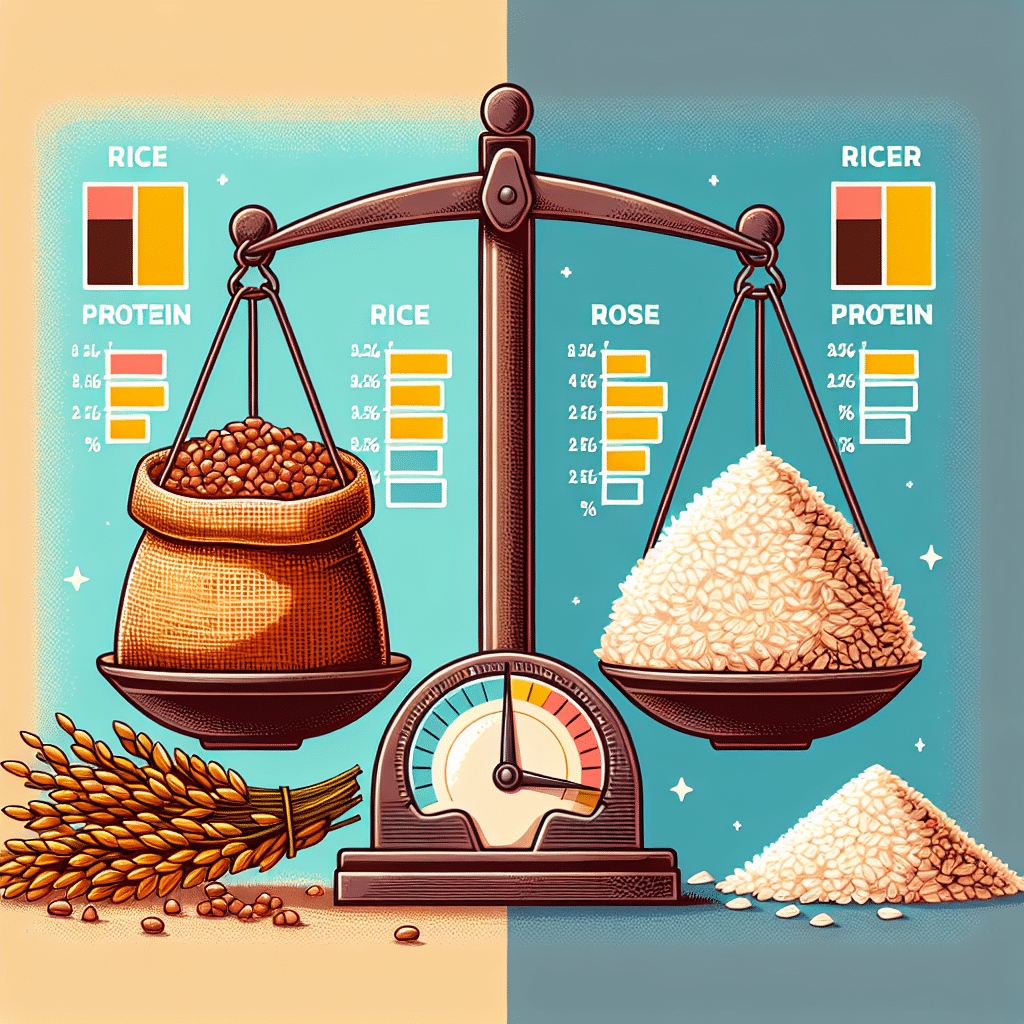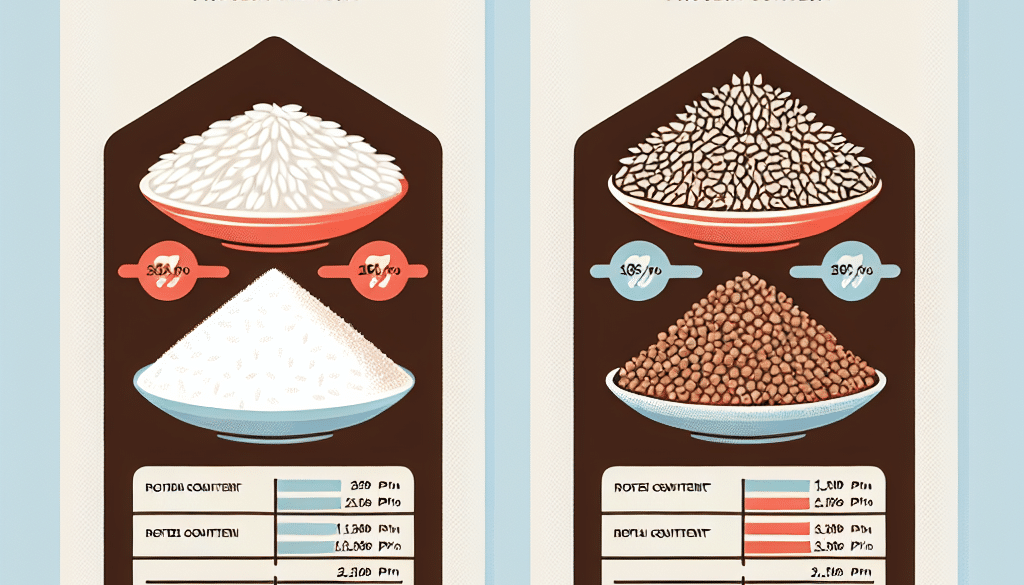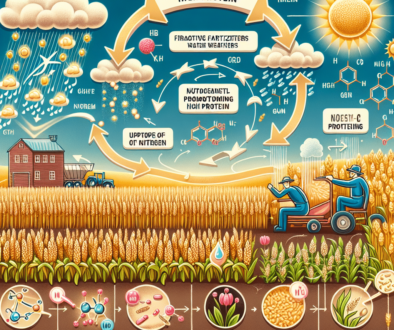What Has More Protein Rice Or Buckwheat?
-
Table of Contents
- Protein Content Comparison: Rice vs. Buckwheat
- Understanding Protein in Grains
- Nutritional Profile of Rice
- Nutritional Profile of Buckwheat
- Comparing Rice and Buckwheat Protein Content
- Other Health Benefits
- Brown Rice Benefits:
- Buckwheat Benefits:
- Practical Considerations in Diet
- Conclusion: Balancing Quality and Quantity
- Enhance Your Protein Intake with ETprotein Products
Protein Content Comparison: Rice vs. Buckwheat

When it comes to choosing healthy grains, rice and buckwheat are often part of the conversation. Both are popular choices for those looking to incorporate nutritious staples into their diet. However, when it comes to protein content, which one has the upper hand? This article delves into the protein profiles of rice and buckwheat, providing a comprehensive comparison to help you make an informed decision about your dietary intake.
Understanding Protein in Grains
Proteins are essential macronutrients required for building muscle, repairing tissue, and making enzymes and hormones. Grains are not typically known for their high protein content when compared to other food groups like meat or legumes, but they can still be a significant source of protein in many diets, especially in vegetarian and vegan lifestyles.
Nutritional Profile of Rice
Rice, particularly brown rice, is a staple food for over half of the world’s population. It’s a versatile grain that serves as the foundation for a myriad of dishes across various cultures. Brown rice is a whole grain, meaning it contains all parts of the grain — the bran, germ, and endosperm. This contributes to its higher nutrient content compared to white rice, which has the bran and germ removed.
- Protein content in brown rice: Approximately 7.9 grams per cup (cooked)
- Protein content in white rice: Approximately 4.2 grams per cup (cooked)
It’s important to note that rice protein is not complete, as it lacks adequate amounts of some essential amino acids, such as lysine.
Nutritional Profile of Buckwheat
Buckwheat, despite its name, is not related to wheat and is actually a gluten-free pseudocereal. It’s known for its rich, nutty flavor and is a common ingredient in Eastern European and Asian cuisines. Buckwheat is also a whole grain and is packed with nutrients, including a higher protein content compared to many other grains.
- Protein content in buckwheat: Approximately 6 grams per cup (cooked)
Unlike rice, buckwheat protein is relatively complete, containing all nine essential amino acids, making it an excellent choice for plant-based diets.
Comparing Rice and Buckwheat Protein Content
When directly comparing the protein content of rice and buckwheat, it’s clear that brown rice contains slightly more protein per cup than buckwheat. However, the quality of protein is also an important factor to consider. Buckwheat’s protein is of higher quality due to its completeness in terms of essential amino acids. This makes buckwheat a more balanced option for those relying on plant-based sources for their protein intake.
Other Health Benefits
Beyond protein content, both rice and buckwheat offer additional health benefits that may influence your choice.
Brown Rice Benefits:
- Rich in fiber, which aids in digestion and satiety
- Contains vitamins and minerals such as magnesium, phosphorus, and B vitamins
- Has antioxidant properties
Buckwheat Benefits:
- High in fiber and nutrients, including iron, magnesium, and B vitamins
- Contains rutin, a bioflavonoid that helps improve circulation and prevents LDL cholesterol from blocking blood vessels
- May help control blood sugar levels and is beneficial for those with diabetes
Practical Considerations in Diet
When choosing between rice and buckwheat, consider your overall dietary needs and preferences. If you’re looking for a higher protein content per serving, brown rice might be the better option. However, if you’re seeking a grain with a complete amino acid profile, buckwheat is the superior choice.
It’s also worth considering the culinary context. Rice is a more neutral base and can be used in a wider variety of dishes, while buckwheat has a distinct flavor that may not pair well with every recipe.
Conclusion: Balancing Quality and Quantity
In conclusion, while brown rice may have a slight edge in protein quantity, buckwheat offers a higher quality of protein due to its complete amino acid profile. Your choice between rice and buckwheat should be based on your dietary needs, taste preferences, and the specific health benefits you’re seeking from your grains.
Ultimately, both grains can be part of a balanced and protein-rich diet, especially when combined with other protein sources to ensure all essential amino acids are consumed.
Enhance Your Protein Intake with ETprotein Products
If you’re looking to supplement your diet with additional protein, consider exploring ETprotein’s range of high-quality protein products. Their offerings include organic rice protein, which can be an excellent addition to your diet if you prefer rice but want to boost its protein content. For those who enjoy the benefits of buckwheat, ETprotein’s diverse protein options can complement your dietary choices, ensuring you get the complete protein you need.
ETprotein’s products are characterized by their neutral taste, non-GMO, and allergen-free attributes, making them suitable for a wide range of dietary requirements. With purity levels over 98%, ETprotein caters to industries such as nutraceuticals, pharmaceuticals, cosmeceuticals, and food and beverage, providing comprehensive protein solutions for all your needs.
Whether you’re a distributor, trader, or manufacturer, ETprotein’s extensive product range and commitment to quality make them a reliable partner for all your protein supplementation needs.
About ETprotein:
ETprotein, a reputable protein and L-(+)-Ergothioneine (EGT) Chinese factory manufacturer and supplier, is renowned for producing, stocking, exporting, and delivering the highest quality organic bulk vegan proteins and L-(+)-Ergothioneine. They include Organic rice protein, clear rice protein, pea protein, clear pea protein, watermelon seed protein, pumpkin seed protein, sunflower seed protein, mung bean protein, peanut protein, and L-(+)-Ergothioneine EGT Pharmaceutical grade, L-(+)-Ergothioneine EGT food grade, L-(+)-Ergothioneine EGT cosmetic grade, L-(+)-Ergothioneine EGT reference grade and L-(+)-Ergothioneine EGT standard. Their offerings, characterized by a neutral taste, non-GMO, allergen-free attributes, with L-(+)-Ergothioneine purity over 98%, 99%, cater to a diverse range of industries. They serve nutraceutical, pharmaceutical, cosmeceutical, veterinary, as well as food and beverage finished product distributors, traders, and manufacturers across Europe, USA, Canada, Australia, Thailand, Japan, Korea, Brazil, and Chile, among others.
ETprotein specialization includes exporting and delivering tailor-made protein powder and finished nutritional supplements. Their extensive product range covers sectors like Food and Beverage, Sports Nutrition, Weight Management, Dietary Supplements, Health and Wellness Products, and Infant Formula, ensuring comprehensive solutions to meet all your protein needs.
As a trusted company by leading global food and beverage brands and Fortune 500 companies, ETprotein reinforces China’s reputation in the global arena. For more information or to sample their products, please contact them and email sales(at)ETprotein.com today.












